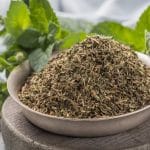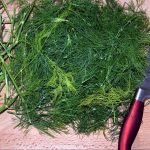In summary, you can use one of three methods to dry fresh cilantro: oven-dry, microwave, or air-dry the leaves after cleaning them.
Cilantro is a green leafy herb with a very pronounced flavor. The herb is used as a garnish or flavoring in savory cooking. With its high water content, cilantro can wilt and become limp within 2 or 3 days of harvesting.
Drying is a great way to preserve cilantro for long-term use without having to waste anything. You can also freeze cilantro to extend its shelf life.
There are a few different ways to dry cilantro depending on the time and equipment you have available. In this guide, you will learn the best way to dry cilantro for quality preservation.
Can You Dry Cilantro?
If you love cilantro, you’ll be happy to know that you can dry cilantro (or coriander) leaves for long term storage. There are several ways to dry the herbs including air drying cilantro, microwaving, and oven drying. You can also use a food dehydrator for drying cilantro effectively.
Air drying is a longer but more natural process compared to using a microwave. Heat drying methods remove not only water but also essential oils, resulting in some flavor loss. Although oven drying and microwaving are faster, air drying the fresh herbs will retain the best quality.
However, if you live in a very humid climate, the moisture in the air will slow the drying process. The leaves may start to mold before they have a chance to fully dry out. In this case, opt for the oven. Once the cilantro is dried, store it in a cool, dry place out of direct sunlight.
How To Dry Cilantro
Here are 3 common methods to go from fresh cilantro to dried:
Method 1: Oven Drying Cilantro
Step 1: Rinse
Lightly rinse the cilantro under running water. Don’t let the leaves spend too much time in the cold water.
Step 2: Dry
Place the leaves on paper towels or on a clean kitchen towel and pat dry. Remove as much excess moisture as possible. You can also use a salad spinner and then let the cilantro air dry for a few minutes.
Remove the fresh cilantro leaves from the stems.
Step 3: Prepare
Spray a baking sheet with non-stick baking spray. Spread the leaves out in a single layer so that they don’t overlap. Make sure the leaves are not clumped together. Alternatively, line the baking sheet with parchment paper.
Step 4: Bake
Preheat the oven to the lowest heat setting. Place the tray in the oven and bake for 30 minutes. If the leaves are not dried after 30 minutes, let them continue to bake at the lowest temperature, checking every 5 minutes to ensure they do not burn.
The time required to dry the leaves can depend on the humidity in the air.
Once the leaves are dry and crispy, remove the tray from the oven and set it aside to cool for 5 to 10 minutes.
Step 5: Pack and Store
The dried cilantro leaves can be stored whole or crushed. If desired, crush the leaves with your fingers or a mortar and pestle. Store the dried cilantro in airtight containers and label them with the date and contents.
Method 2: Microwave
Step 1: Clean
If the cilantro leaves are dirty, wipe them lightly with a dry or slightly damp cloth. You want the leaves to be as dry as possible before starting the dehydration process. Remove the leaves from the stem.
Step 2: Prepare
Place a piece of paper towel onto a microwaveable plate. Arrange the cilantro in a single layer on a paper towel. Place another paper towel on top of the leaves.
Step 3: Microwave
Microwave the leaves on high power for two minutes. Check the leaves. If they are not completely dry, keep microwaving them in 15-second intervals until completely dehydrated.
Step 4: Pack
Remove the plate from the microwave. Allow the cilantro leaves to cool for a few minutes. Crush the dried leaves with a mortar and pestle or with your fingers. Pack the herbs into spice bottles, airtight containers, or an airtight jar. Label the jar with the date and contents.
Method 3: Air Dry Cilantro by Hanging
Step 1: Clean
Wipe any dirt off the leaves with a clean, dry, or slightly damp cloth if needed.
Step 2: Tie Bundles
Tie a bunch of cilantro stalks together with an elastic or string. Don’t make the bundles too big to ensure air can circulate evenly throughout the whole bunch.
Step 3: Hang
Hang the cilantro bundles to dry with the leaves hanging downwards. Choose a light area with good air circulation. Avoid humid areas such as near a stove or bathroom.
To protect the herbs from dust, loosely cover each bundle with a perforated paper bag. Punch holes in the bag and leave the bottom open. Do not use a plastic bag as this will prevent airflow and cause mold.
After 1 to 2 weeks the leaves should be dry and brittle. The drying time will depend on the climate. Properly dehydrated cilantro should crumble easily when handled.
Step 4: Pack
Remove the dried cilantro leaves from the stem ends and crush the herbs into smaller pieces. Store the dried, crushed herbs in an airtight container and label it with the date and contents.
Types of Cilantro
Cilantro is also known as dhania, coriander, or Chinese parsley. The entire plant, including the root, is edible. The fresh leaves and dried seeds (referred to as coriander seeds) are the most commonly used parts and are incorporated in a wide range of cooking techniques.
Cilantro leaves have a slight lemon/lime flavor, although many people liken the taste to dish soap.
Fresh leaves are used in chutneys, salsa, salad, guacamole, and to garnish almost any savory dish. Cilantro root is generally only used in Asian cuisines such as Thai curry paste and soup.
FAQs
Conclusion
Cilantro has a strong, distinctive flavor. The fresh herb is used as a garnish, in salsa, salad, dressing, guacamole, and chutney. Dried coriander is best used in cooked dishes such as curries, sauces, soups, and stews.
Before packing dried cilantro, make sure that the herbs are completely dehydrated. If there is still moisture present, mold will develop during storage.
Take good care of your dried herbs when storing by keeping them in a cool, dry area out of direct sunlight. This way you will be stocked up on flavor for an entire year.
Check our other guides on how to dry parsley leaves, oregano, and basil.

*image by rezkrr/depositphotos









